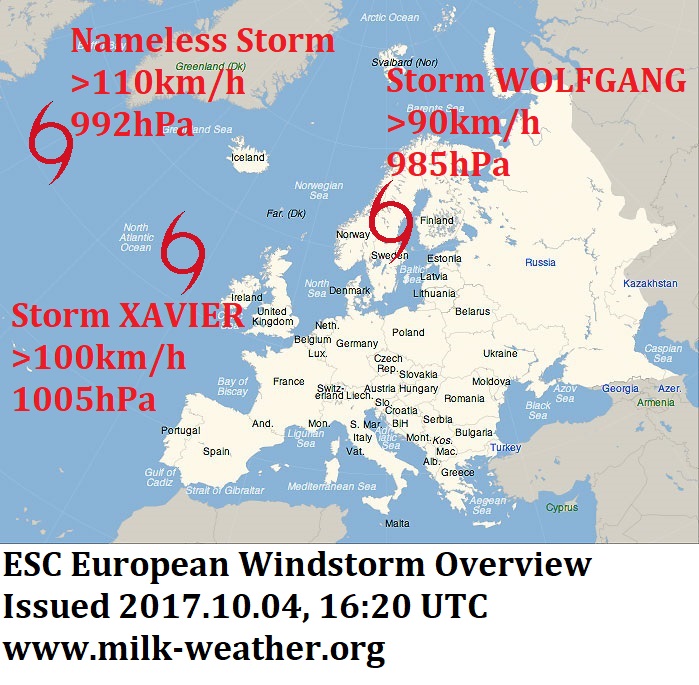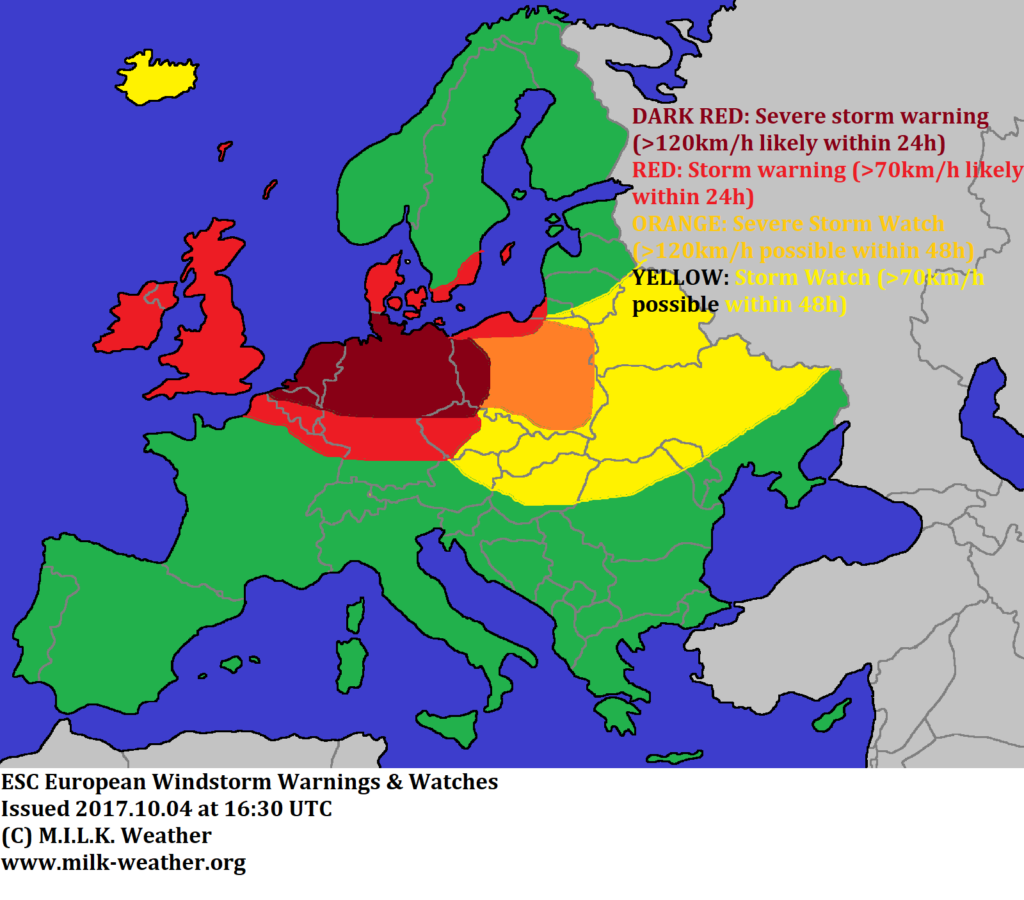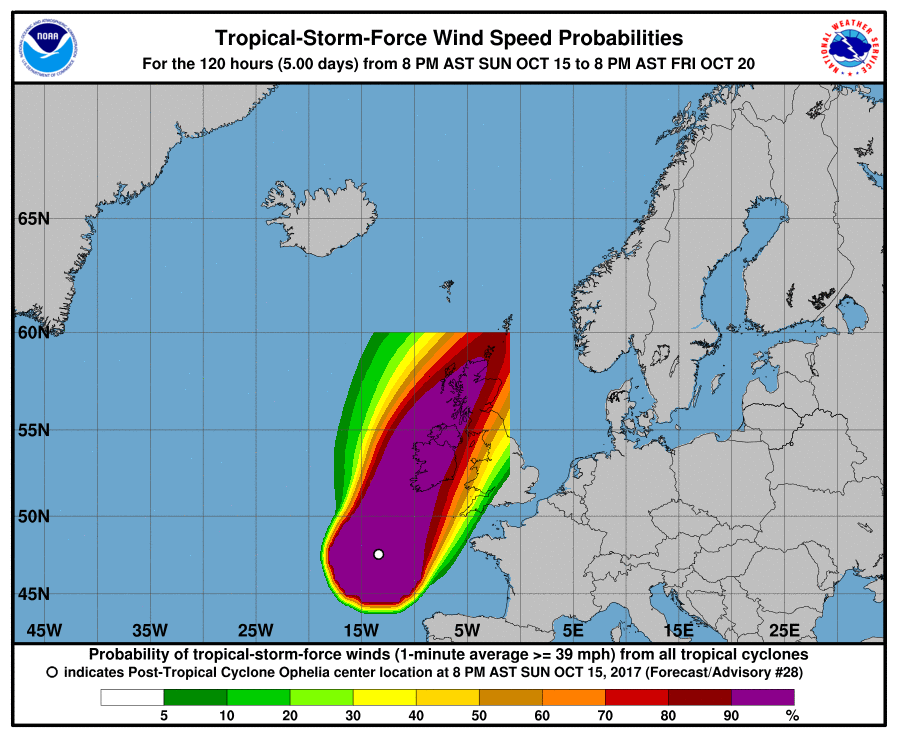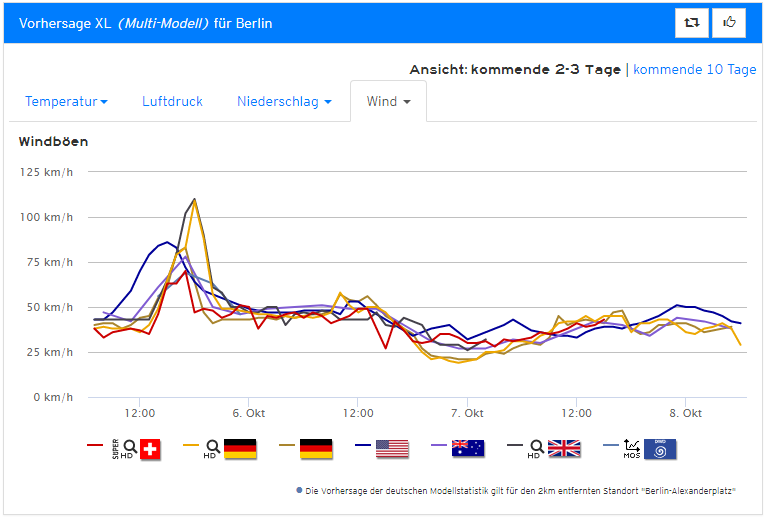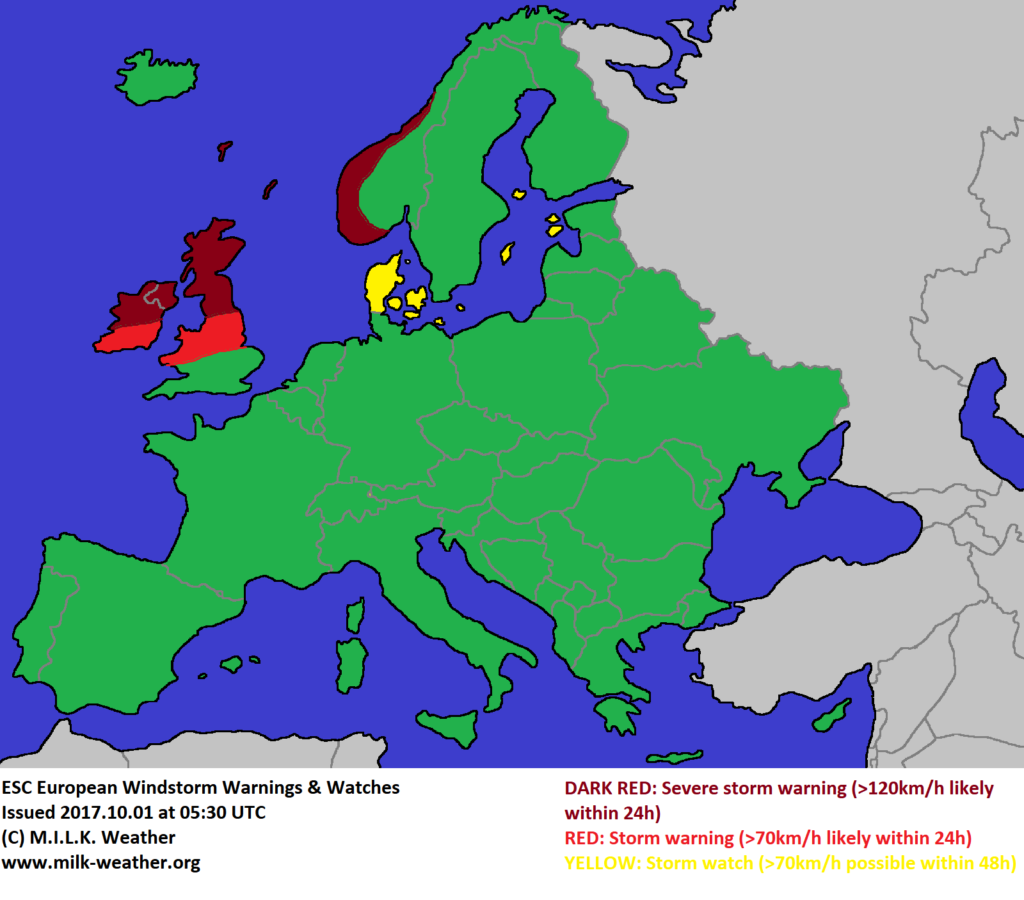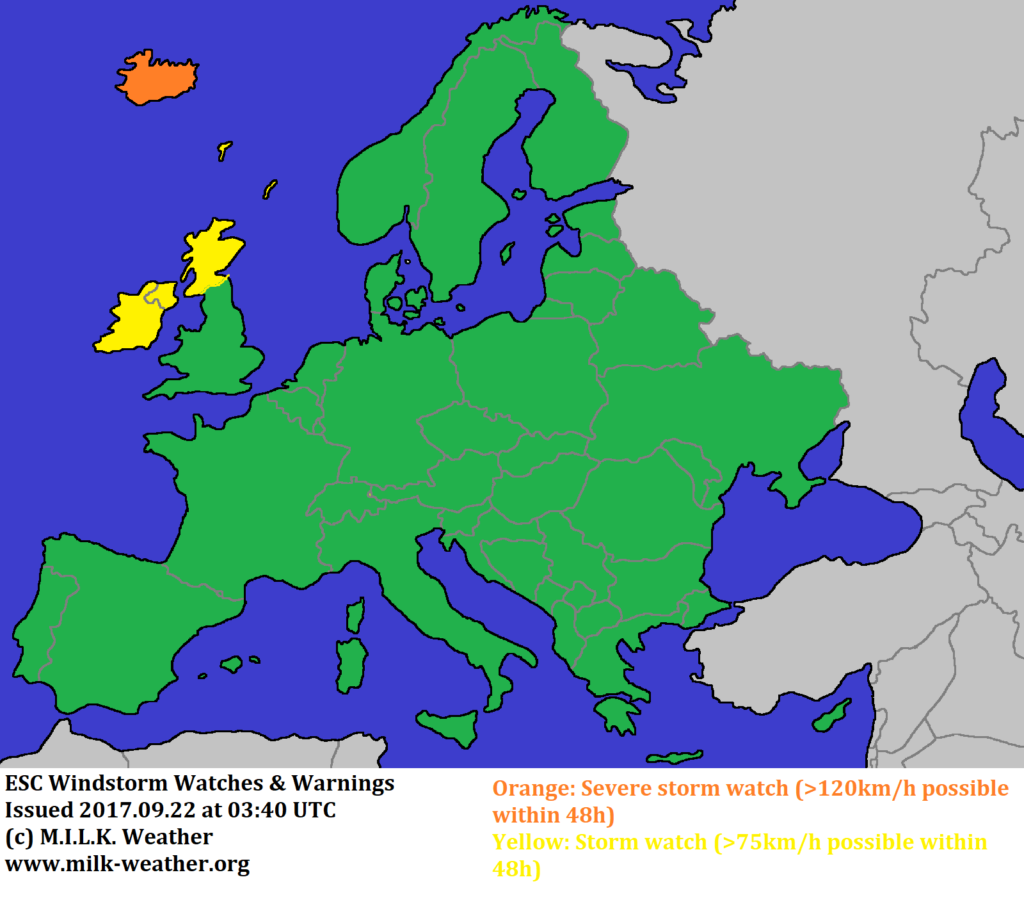DEUTSCHE VORHERSAGE UNTER DER ENGLISCHEN!
For the sake of enabling a detailed analysis of the predicted path of storm XAVIER, we will focus on this storm in this European Windstorm Update. Warnings & Watches as well as the overview of other ongoing storms in & around Europe can be found on the maps below.
Storm XAVIER is currently located to the northwest of Ireland, with wind peaks exceeding 100km/h and a current central pressure of 1005hPa. Currently, the storm is little more than a normal autumn low pressure system over the Atlantic, and though it will bring a windy night to the UK and Ireland, it will only really start to intensify over the North Sea in the second half of the night. The storm is – and will stay – fairly compact, and there are still uncertainties regarding where the storm field will be when and how strong it will be in different places at different times, but this is the latest forecast:
The Predicted Path
Storm XAVIER will rapidly intensify over the North Sea after it has crossed the British Isles, turning from a regular Storm into a “severe storm” (a category reserved for storms packing hurricane-forced gusts). Serious storm gusts will first make landfall on the Dutch and Belgian coasts in the morning hours between 4 and 6 am local time, with gusts around 110km/h expected along much of the coast. The storm will continue to intensify and wind speeds may continue to increase throughout the morning.
As the morning progresses, the wind field will start moving further inland, with storm gusts between 70 and 90km/h expected in much of the Netherlands and the first storm gusts arriving in western Germany.
Around noon or in the early afternoon, the area with the most intense wind will have moved on from the Netherlands to Germany, and the storm may temporarily lose a bit of strength, though storm gusts around 90km/h are nonetheless expected throughout much of northwestern Germany.
HOWEVER, as the storm moves eastward across Germany, it is expected to quickly re-gain energy within only a few hours, with gusts around 110km/h to be expected in much of central Germany, and wind peaks likely to well exceed 120km/h in exposed locations (such as the Brocken mountain and the mountains of Saxony).
The storm will continue to move in the general direction of east-southeast, and in the later afternoon gusts ranging anywhere from 90 to over 130km/h are expected throughout most of Eastern Germany, including Berlin. The mountains of Saxony are likely to be exposed to especially harsh conditions, but serious wind speeds are expected for all other areas of eastern Germany at this time as well.
As the sun sets, the wind field will move into Poland and will start to calm down in Germany. Storm watches have been issued for eastern Europe, including Poland. See the map below for more details.
Risks
Trees, branches, scaffolding, roof shingles and lose objects may fall and be blown around. In the city also beware of objects that may potentially be blown off balconies. There may be a significant impact on transportation on the road and railway networks, flight delays or even cancellations. Stay indoors when possible, and keep clear of trees.
#################################
Um eine detaillierte Analyse der erwarteten Zugbahn von XAVIER zu ermöglichen, werden wir uns in dieser Vorhersage auf diesen Sturm konzentrieren. Warnungen, Vorwarnungen und eine Übersicht über aller derzeitigen Stürme in & um Europa können Sie auf den Karten unten finden.
Sturm XAVIER liegt derzeit nordwestlich von Irland, mit Windspitzen um 100km/h und einem derzeitigen Luftdruck von 1005hPa in seinem Zentrum. Damit ist XAVIER derzeit nicht viel mehr als ein gewöhnlicher Herbststurm, der in der kommenden Nacht etwas wind nach Irland und Großbritannien bringen wird. Erst in der zweiten Nachthälfte wird der Sturm anfangen sich rasant zu verstärken. Der Sturm ist relativ kompakt, und wird das voraussichtlich auch bleiben; so gibt es noch Unsicherheiten darüber wann, wo, und wie stark der Sturm genau treffen wird. Hier ist allerdings der neuste Stand der Vorhersagen:
Die Vorhergesagte Zugbahn
Nachdem XAVIER die Britischen Inseln überquert hat, wird er sich über der Nordsee rasant verstärken und sich von einem normalen Sturm in einen Orkan (mit Böen über 120km/h) verwandeln. Orkanartige Böen um 110km/h werden zwischen 4 und 6 in der Früh Ortszeit in Holland und Belgien die Küste erreichen. Der Sturm wird sich dann in den kommenden Stunden voraussichtlich weiter verstärken, und auch die Windgeschwindigkeiten können noch etwas steigen.
Im weiteren Verlauf des Morgens wird das Sturmfeld anfangen, sich weiter landeinwärts zu verschieben, und Sturmböen zwischen 70 und 90km/h sind in den gesamten Niederlanden zu erwarten. Der ersten Sturmböen werden außerdem im Nordwesten Deutschlands ankommen.
Rund um Mittag oder am frühen Nachmittag wird sich der Schwerpunkt des Sturmes von den Niederlanden nach Nordwestdeutschland verlagern, und XAVIER wird womöglich temporär etwas an Kraft verlieren – es ist aber weiterhin verbreitet mit Sturmböen um 90km/h im Nordwesten zu rechnen!
ALLERDINGS: während sich der Sturm weiter ostwärts über Deutschland bewegt, wird XAVIER innerhalb weniger Stunden wieder schnell Energie gewinnen, und mit verbreitet orkanartigen Böen um 110km/h – sowie Böen weit über 120km/h in exponierten Lagen – Mitteldeutschland heimsuchen (der Brocken und das Erzgebirge werden vermutlich besonders hohe Windgeschwindigkeiten abbekommen).
XAVIER wird sich im Laufe des Nachmittags weiter nach Südsüdosten verlagern, und am späteren Nachmittag ist im gesamten Osten Deutschlands mit Böen zwischen 90 und 130km/h zu rechnen. Auch Berlin wird von dem Sturm betroffen sein. Das Erzgebirge wird voraussichtlich besonders heftigen Sturmböen ausgesetzt sein, allerdings werden in Ostdeutschland überall orkanartige Böen zu erwarten sein.
Am Abend wird sich das Sturmfeld von Deutschland nach Polen verlagern und der Wind wird sich in Deutschland wieder etwas beruhigen. Entsprechende Vorwarnungen sind auf der Karte unten zu finden.
Gefahren
Bäume, Äste, Baugerüste, Dachziegel und lose Gegenstände können fallen oder herum geblasen werden. Seien Sie in der Stadt außerdem vorsichtig vor Dingen, die von Balkonen stürzen können. Es kann zu teils erheblichen Behinderungen auf der Straße und auf den Schienen kommen, sowie zu Verspätungen und Ausfällen im Flugverkehr. Wenn möglich, bleiben Sie drinnen. Halten Sie sich unbedingt von Bäumen fern.
Below, you will find the ESC European Windstorm Overview, as well as the Windstorm Warnings & Watches.
